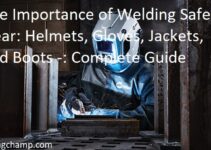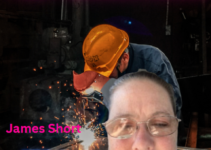Do you want to remain safe and productive in the workplace? Investing in a welding helmet that is respirator compatible can be a game-changer.
This guide will help you understand the benefits and features of welding helmets with respirator compatibility while keeping you safe against workplace hazards.
Welding helmets with respirator compatibility provide a safe and comfortable environment for welders, meaning they have the ability to wear protection like a face mask while still having the ability to clearly see the task at hand. Welding helmets are essential for welders who need to protect their eyes from dangerous flashes of light, sparks, and flying debris. The addition of respirator compatibility allows for those with respiratory issues or needs to wear a face mask without compromising on their visibility.
This guide will explain all the benefits and features associated with welding helmets that offer respirator compatibility. We’ll start with an introduction to welding helmets that offer respirator compatibility and then go into details about what makes them so advantageous for welders who need extra protection from potentially harmful dusts and fumes in their line of work. We’ll cover considerations when shopping for these types of helmets, safety ratings, and recommendations on some good brands. Finally, we’ll draw conclusions based on our analysis so you can make an educated decision when selecting your welding helmet.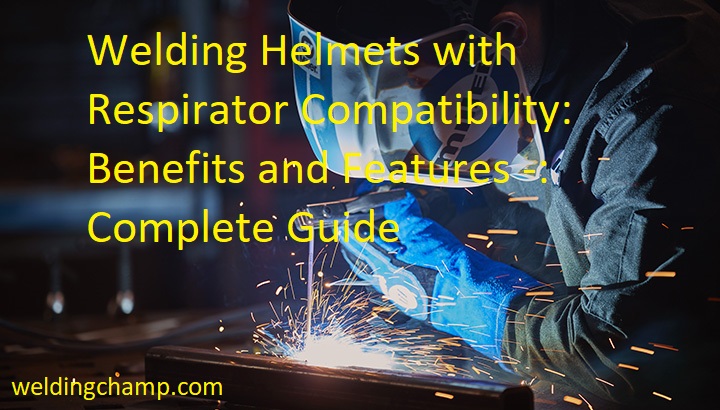
Benefits of Welding Helmets with Respirator Compatibility
Welding helmets with respirator compatibility offer a number of benefits that can make working in hazardous environments safer and more comfortable. These include providing protection from fumes and particles, improving air quality, allowing workers to wear additional protection, making hazardous tasks easier to perform, and reducing chances of exhaustion or fatigue.
The ability to combine a welding helmet with a respirator makes it possible for welders to take on more dangerous tasks with improved visibility and less worry about exposure to harmful fumes. This helps increase safety for welders as well as other workers in the area who may be exposed to the same hazardous materials. The extra protection also helps reduce strain on the welders’ lungs, as it keeps them from having to breathe in potentially dangerous air particles.
Having a welding helmet combined with a respirator also increases visibility when performing certain kinds of welding tasks. It enables welders to see what they are doing, while protecting their eyes and face from direct contact with sparks or smoke created by the welding process. With this combination in place, there is less risk of injury due to accidental contact. Additionally, it allows wearers to wear additional protective gloves or clothing without worrying about sacrificing visibility or comfort while wearing them.
Finally, because breathing is not restricted while using a welding helmet with respirator compatibility, wearers can work longer hours without feeling exhausted or fatigued due to small changes in temperature caused by increased ventilation compared to traditional masks without respiratory attachments. This means less down time for welders when completing dangerous projects in areas where proper ventilation is limited or nonexistent.
Protection from hazardous fumes and particles
Welding helmets with respirator compatibility offer increased protection from hazardous fumes and particles. Traditional welding helmets provide simple protection from the sparks and spatter of welding operations, but they don’t protect against hazardous fumes, particulates, and other airborne contaminants generated by the welding process. Modern welding helmets with respirator compatibility are designed to provide comprehensive protection to the head, face, eyes, ears and respiratory system during more demanding welding operations involving hazardous materials in enclosed spaces or contaminated environments.
The respirators used with these welding helmets form a seal around the wearer’s face that prevents any air from entering or exiting without first passing through one or more filters designed to trap particulate matter before it enters into contact with the wearer’s lungs. Additionally, many of these respirators also feature highly advanced cartridges which will capture a range of hazardous gases and vapors commonly found in industrial workplaces.
These state-of-the-art systems enable welders to work safely in tight spaces or exposed environments where contamination levels may be high enough for traditional protective equipment to become ineffective.
Improved respiratory health and safety
Welding helmets with respirator compatibility offer a variety of advantages beyond what standard welding helmets provide. Respirators are specifically designed to protect a worker from breathing in hazardous particles in the air. Additionally, they can provide increased comfort during prolonged periods of wear and improve overall respiratory health and safety. Some of the most beneficial features that come with respirator compatible welding helmets include:
- Increased protection against dangerous fumes and particulate matter: Respirator compatible welding helmets are equipped with air purification technology to effectively filter out dangerous fumes and particulate matter. This helps prevent exposure to toxic weld fumes, smoke and other hazardous materials generated during the welding process.
- Reduced fatigue caused by prolonged periods of wear: The addition of a built-in respirator reduces the strain placed on the lungs when inhaling and exhaling, resulting in improved comfort when wearing for extended periods.
- Improved visibility: These helmets contain a clear visor that enables wearers to clearly view their work while maintaining full protection from harmful elements contained in weld smoke or dust. The improved visibility also helps reduce eyestrain related fatigue during long work sessions.
- Increased cooling effect: To help keep wearers cool while working in hot environments, these helmets are designed to pull cool outside air into the helmet through an attached intake port. This works to maintain equilibrium temperatures within the protective face-piece which can help reduce fatigue caused by extreme heat sources found near welders at job sites.
Features to Look for in Welding Helmets with Respirator Compatibility
When researching welding helmets with respirator compatibility, it is important to become familiar with the various features and benefits that are available. Here are a few important attributes to look for:
Protection Against Sparks and Spatter: The helmet should provide protection against sparks and spatter so that your eyes and face stay safe while you’re working. The helmet should also shield your neck from any molten metal that may unexpectedly be flung in its direction.
Spark Deflector Design: Some welding helmets feature a spark deflector design which helps protect you against sparks. This type of design reduces the amount of heat generated around the material being welded, thus offering an extra layer of protection against potential harm or injury.
Adjustable headgear: Helmets with adjustable headgear allow for a customized fit for optimal comfort and visibility. With adjustable headgear, it won’t matter if you have a small or large head, because this feature can help ensure the best fit possible.
Auto-Darkening Filter (ADF): An ADF helps block out brighter light when sparks begin flying, making it safer and easier to see your target area without having to switch lenses in between tasks. This means less time wasted between tasks which makes the job more efficient overall!
Respirator Compatibility: Many welding helmets now offer respirator compatibility through special adapter pieces which make it much easier to securely attach a respirator mask directly onto the helmet itself. This eliminates having to wear separate protective gear when performing tasks like grinding or cutting, which can help protect your lungs from hazardous fumes in enclosed spaces or poorly-ventilated areas where airborne toxins may linger.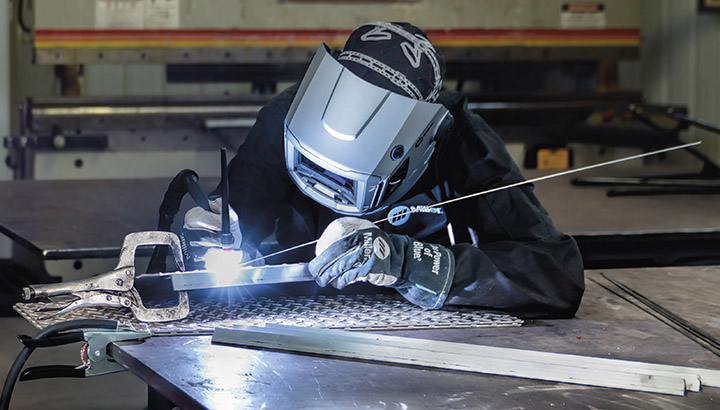
Respirator compatibility
Safety is of paramount importance when welding, and it’s important to know that the welding helmet you choose has respirator compatibility. Respirators provide another layer of protection against the harmful fumes and vapors associated with welding, and they need to be used in combination with a welding helmet to ensure proper protection. Respirator compatibility is often found on helmets labeled with the “NIOSH approved” sticker, meaning they are deemed safe for such use.
Respirator compatible helmets offer two big advantages– increased safety and improved user comfort due to a more ergonomic design. They typically feature larger helmets or enhanced viewing areas, which allow wearers to extend their view over the respirator and see their work more effectively. The increased safety comes from maintaining a proper seal of the respirator mask against skin- particularly any facial hair that might impede sealing- in order to ensure no foul gases can leak into your breathing space. Additionally, many supplies provider masks that have been designed for specific helmets for improved fitment.
Adjustable airflow
When it comes to welding helmets that offer respirator compatibility, adjustable airflow is a key benefit. This feature allows the wearer to control the amount of air that enters their helmet and respirator, helping them to find an optimal level of comfort. When set properly, the adjustable airflow allows clean, cool air to circulate inside the helmet and respirator while also efficiently venting away moisture and heat.
With this type of system, welders can be sure that they are working in safe and comfortable conditions when controlling hazardous fumes. In addition, with greater airflow comes improved visibility as fine particles or low levels of smoke can be removed or filtered out and proper lighting conditions are maintained in extreme welding environments.
How to Choose the Best Welding Helmet with Respirator Compatibility
When selecting a welding helmet with respirator compatibility, there are several features to consider. For example, each manufacturer produces a range of helmets for a variety of welding applications. Some specialize in welding in confined spaces or overhead work, while others offer models designed for comfort and mobility. Additionally, the type of lens and its ventilation system will also determine which type of helmet is best suited for your needs.
Lens Types: Auto-darkening lenses provide protection from the arc light and shield you from the weld’s UV radiation. The lens should also come with adjustable sensitivity and delay settings, as well as flip-up options that allow you to have both hands free when not welding. Features like grind mode ensure optimum visibility when grinding or cutting metal.
Ventilation System: It’s important to make sure there is adequate air circulation in the helmet to avoid fogging or condensation build-up. Look for features such as vents at the top, back and sides of the lens, plus integrated exhaust ports that draw particles out freely from the welder’s face area without obstructing their vision.
Coverage: Ensure that your chosen helmet offers enough coverage specifically designed to protect your entire face when wearing respirator equipment underneath it – this includes your eyes and ears separated by material with breathable side panels protecting your neck and face areas exposed directly to welding sources like sparks or heat radiation. It should also come with a secure fitment system that prevents any accidental lifting due to sudden movement while working on multiple welds in succession.
Identify your welding needs
Identifying the type of welding job you plan to undertake is a critical first step as there are various techniques and projects that require different types of protective equipment. Knowing right away what type of welding will be performed can help narrow down the selection of safety gear needed.
Whether you’re welding for structural, aircraft maintenance, automotive or other reasons, make sure to prioritize safety and select welding helmets with face protection and respirator compatibility. It is also important to learn about other features that these helmets may be equipped with from flame resistance and visual aids to quality air filtration systems.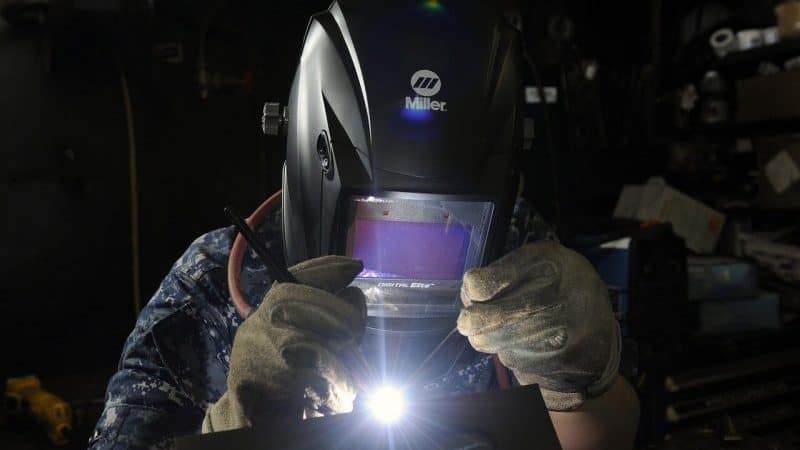
Determine your budget
Determining the budget for your welding helmet is a very important step. Before looking into specific features and models, you should first decide how much you are willing to spend.
Keep in mind that a welding helmet with respirator compatibility can be significantly more expensive than one without, so it is important to consider the budgetary restrictions of your particular project or employer. For example, if you are working on a single-person project, then you may be limited to investing only a few hundred dollars into this purchase, whereas an employer might be able to invest several thousand depending on the scope of their project.
When deciding on your budget, it is important to take into account not just the initial cost of the helmet but any necessary accessories as well as regular maintenance and upkeep needed over time.
Conclusion
In conclusion, welding helmets with respirator compatibility help protect workers by providing a safe, secure way to filter fumes and dust as they weld. These products are available from a variety of retailers and manufacturers, so it’s important to do your research and select the product that best fits your needs.
Respirator compatibility helps offer superior protection for the welder, ensuring protection from airborne particles like dust and metal particles, as well as other gases or impurities in the environment. In addition, these helmets are designed with adjustable airflow settings that allow users to conveniently adjust their breathing environment based on their individual preferences or needs. This feature allows users to achieve an optimal welding experience with maximum productivity while still properly protecting their eyes and face from heat, sparks, dust and debris.
FAQ’S
What are the features of a welding helmet?
Some features of a welding helmet include an auto-darkening lens, adjustable shade settings, comfortable headgear, and a durable shell to protect the head and face from sparks and debris.
What is the purpose of welding respirator?
The purpose of a welding respirator is to protect the welder from inhaling harmful fumes and particles generated during the welding process.
What are the benefits of welding helmet?
Welding helmets provide protection for the eyes, face, and head from intense light, sparks, and debris generated during the welding process, and can help prevent eye damage and burns.
How effective are respirators for welding?
Respirators can be highly effective for protecting welders from inhaling harmful fumes and particles generated during welding, but it is important to use the correct type of respirator and ensure proper fit and use.
What are the safety features of a helmet?
Safety features of a welding helmet may include a durable shell to protect against impact, an auto-darkening lens to protect against bright light, and comfortable, adjustable headgear.
What are the features of a smart helmet?
A smart welding helmet may include features such as Bluetooth connectivity, built-in cameras, and sensors to detect hazardous conditions and alert the welder.
What are the safety standards for welding helmets?
The safety standards for welding helmets may vary by country, but generally include requirements for impact resistance, optical clarity, and protection from ultraviolet and infrared radiation.
Which is the most significant factor in choosing a welding helmet?
The most significant factor in choosing a welding helmet is ensuring that it provides adequate protection for the eyes, face, and head during the specific type of welding being performed.
What are the 2 types of radiation that your welding helmet will protect you from?
Welding helmets can protect from ultraviolet (UV) and infrared (IR) radiation generated during the welding process.
What kind of respirator do you use for welding?
The type of respirator used for welding depends on the type of welding being performed and the specific fumes and particles generated. Some common types of respirators used for welding include N95 disposable respirators, half-face respirators, and powered air-purifying respirators.
See more-
- Best welding machine for beginners 2023
- Best welding machine 2023
- Best welding rod for beginners 2023
- Best welding shirts 2023
- Best welding table 2023
